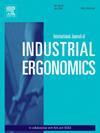The relationship between coal miners’ Big Five personality traits and risk propensity: Evidence from fNIRS
IF 3
2区 工程技术
Q2 ENGINEERING, INDUSTRIAL
International Journal of Industrial Ergonomics
Pub Date : 2025-04-28
DOI:10.1016/j.ergon.2025.103750
引用次数: 0
Abstract
Frequent coal mine accidents are primarily caused by unsafe behaviors among coal miners (hereafter referred to as “miners”), with miners' risk propensity being the key factor driving these behaviors. This study used the Chinese version of the Big Five Inventory-2 to measure personality traits and employed the Balloon Analogue Risk Task as the experimental paradigm. A functional near-infrared spectroscopy (fNIRS) device was used to collect blood oxygenation signals from a specific prefrontal lobe region during miners' participation in the experiment. From a behavioral science perspective, this study clarified the relationship between miners' Big Five personality traits and risk propensity. From a cognitive neuroscience perspective, this study identified the changing patterns of mean relative oxygenated hemoglobin (HbO) concentration and activation levels associated with miners' Big Five personality traits and risk propensity. The results demonstrate that (1) the complex relationships among miners' Big Five personality traits, risk propensity, and risk feedback sensitivity are clarified. (2) Regarding risk propensity and risk feedback sensitivity, statistically significant differences in mean relative HbO concentration and activation levels were identified across channels and regions of interest among miners with high and low levels in each personality dimension. (3) Considering both the characteristics of the Big Five personality traits and the quantitative indicators of fNIRS channels, preliminary theoretical strategies were proposed to enhance miners’ risk propensity at both individual and team levels.
煤矿工人五大人格特征与风险倾向的关系:来自近红外光谱的证据
煤矿事故频发的主要原因是煤矿工人(以下简称“矿工”)的不安全行为,而矿工的风险倾向是驱动这些行为的关键因素。本研究采用中国版大五量表-2测量人格特质,并采用气球模拟风险任务作为实验范式。在矿工参与实验期间,使用功能性近红外光谱(fNIRS)设备收集来自特定前额叶区域的血氧信号。本研究从行为科学的角度,明确了矿工五大人格特征与风险倾向的关系。从认知神经科学的角度,本研究确定了矿工五大人格特征和风险倾向相关的平均相对氧合血红蛋白(HbO)浓度和激活水平的变化模式。结果表明:(1)明确了矿工五大人格特质与风险倾向、风险反馈敏感性之间的复杂关系。(2)在风险倾向和风险反馈敏感性方面,各人格维度高、低水平矿工的平均相对HbO浓度和激活水平在各通道和兴趣区域存在显著差异。(3)结合五大人格特质特征和fNIRS渠道的定量指标,提出了在个体和团队层面提升矿工风险倾向的初步理论策略。
本文章由计算机程序翻译,如有差异,请以英文原文为准。
求助全文
约1分钟内获得全文
求助全文
来源期刊
CiteScore
6.40
自引率
12.90%
发文量
110
审稿时长
56 days
期刊介绍:
The journal publishes original contributions that add to our understanding of the role of humans in today systems and the interactions thereof with various system components. The journal typically covers the following areas: industrial and occupational ergonomics, design of systems, tools and equipment, human performance measurement and modeling, human productivity, humans in technologically complex systems, and safety. The focus of the articles includes basic theoretical advances, applications, case studies, new methodologies and procedures; and empirical studies.

 求助内容:
求助内容: 应助结果提醒方式:
应助结果提醒方式:


